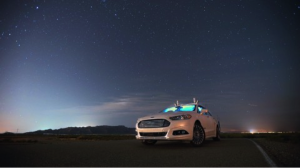Ford is one of 11 companies that have autonomous-vehicle testing permits, according to December data from the California DMV. And California is the place leading the way in developing regulations for self-driving vehicles. The state’s Department of Motor Vehicles is finalizing regulations for the everyday use of autonomous cars with the goal of releasing them in 2017. The DMV website shows “The regulations for the post-testing deployment of autonomous vehicles are currently under development. The regulations will establish the requirements that manufacturers must meet to certify that their autonomous vehicle has been successfully tested, meets certain safety requirements, and is ready for the general public to operate on public roads.”
The concern by developers, like Ford, is that California’s discussed regulations indicate the need for a certified driver and a wheel making the exact point of a self-driving vehicle, for such people as the visually impaired, unusable.
Bloomberg Technology writes in a February article that , Bryan Bashin, the 60-year executive director of LightHouse for the Blind and Visually Impaired in San Francisco who uses a long, white cane to maneuver city streets, said a driverless car “would be one of the biggest advances for the blind since talking computers or even Braille.” It represents freedom from the hassles of public transit and makes suburban destinations attainable, he said.”
Spurring on development to achieve this goal is what Ford has been doing with its recently released study using LiDAR sensors. The Ford Blog has the following information:
Engineers have been testing their “Project Nightonomy” on a Ford Fusion Hybrid autonomous research vehicle at the Ford Arizona Proving Ground. Engineers rode in the vehicle and monitored from outside; tracking the vehicle as it flawlessly steered around winding roads on a pitch-black night.
How it works:
Ford’s LiDAR sensors work with existing virtual driver software to navigate enough desert roads to create a system that tackles twisting tracks, even in near-total darkness. The 2.8 million laser pulses sent per second by LiDAR sensors scan and precisely map the surrounding area. Jim McBride, Ford technical leader for autonomous vehicles, says the resulting 3D, real-time environments contain information on the road, geography, topography and landmarks, rather than relying on “the sun shining or cameras detecting painted white lines on the asphalt.”
Think of it as night-vision goggles for your autonomous car partnering with the existing cameras and radar to allow your Ford to function independently on roads without stoplights. “Nightonomous” driving is another Ford development that brings autonomous driving closer to reality and less like a shot in the dark.
Ford’s continued success could help many visually impaired people and open up a massive market.
According to the Bloomberg Technology article “The sale of autonomous car components is expected to grow from $42 billion in 2025 to $77 billion by 2035, according to Boston Consulting Group data. The cars could represent 25 percent of the worldwide market by 2035, the data show.”
Developing safe, self-driving vehicles that can open up a world of difference in the lives of the visually impaired is a Ford priority.

